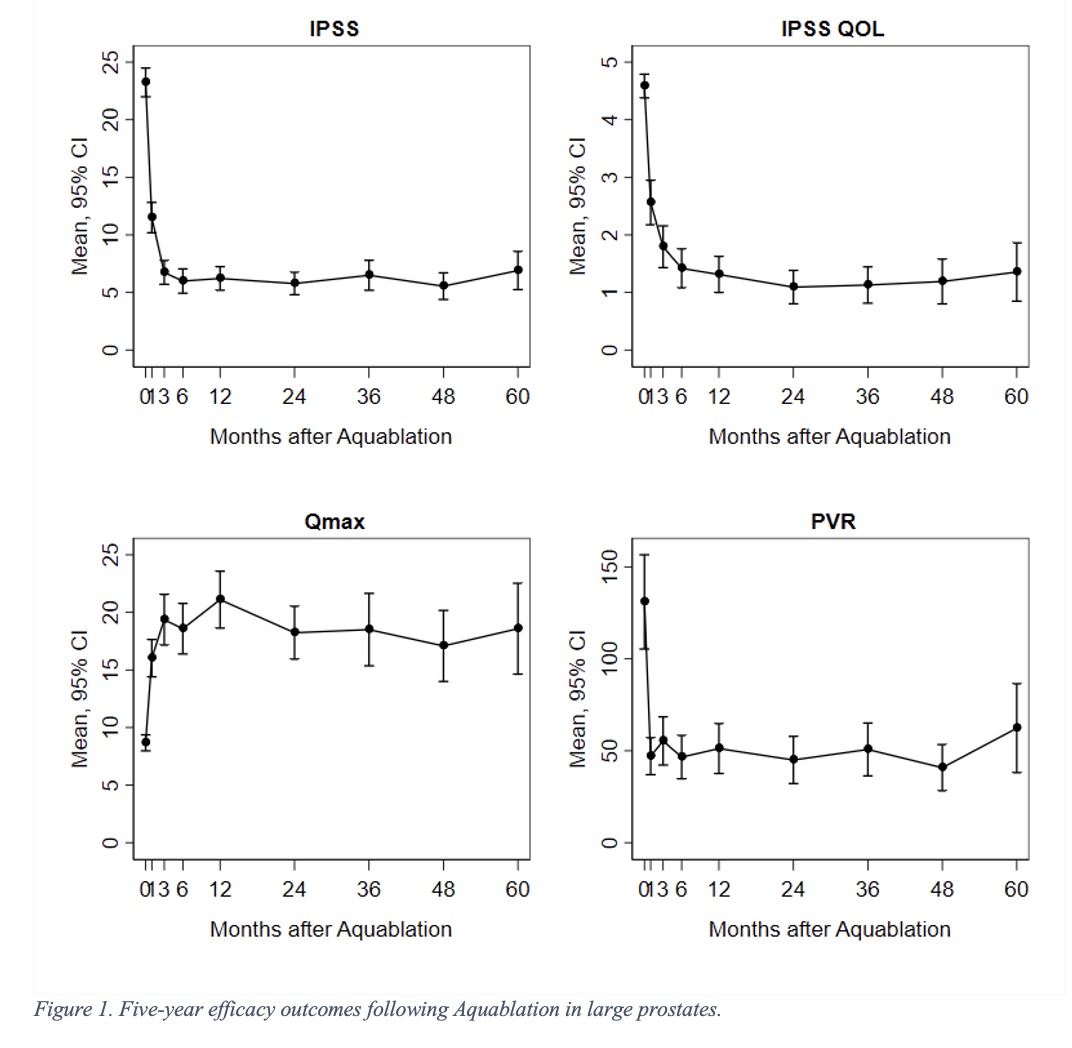Back
Introduction: To report 5-year safety and efficacy outcomes of the Aquablation procedure for the treatment of men with symptomatic benign prostatic hyperplasia (BPH) and large-volume prostate glands.
Methods: 101 men with moderate-to-severe BPH symptoms and prostate volumes between 80-150mL underwent a robotic-assisted Aquablation procedure in a prospective multicenter international trial. Herein we report the final 5-year results.
Results: The study successfully met its safety and efficacy performance goal, which was based upon TURP outcomes typically done in smaller prostates, at three months. Mean prostate volume was 107mL (range 80-150mL). Mean operative time (TRUS in to catheter in), was 55 minutes (range 24-111 minutes) and mean Aquablation resection time was 8 minutes (range 2.5-17 minutes). Most (89%) adverse events were low grade defined as either non-procedure related or Clavien-Dindo grade 2 or less. There was no reported de novo erectile dysfunction and 15% of patients developed ejaculatory dysfunction. The TRUS results showed a 42% reduction in prostate volume at 3 months, which aligned to the 44% reduction in serum PSA at 6 months. At 5-years, IPSS scores improved from 23.2 at baseline to 6.9 and Qmax improved from 8.7 cc/sec at baseline to 18.6 cc/sec. Improvements in both IPSS, IPSS Quality of Life, Qmax, and PVR were immediate (p <.0001) and sustained (p <.0001) throughout the follow-up period, Figure 1. The annualized retreatment rate was less than 1% per year.
Conclusions: At 5-year of prospective follow-up, the Aquablation procedure was shown to be safe and effective in men with large prostates (80-150mL). ClinicalTrials.gov number, NCT03123250. SOURCE OF
Funding: Procept BioRobotics

Moderated Poster Session
Session: MP13: Benign Prostatic Hyperplasia: Surgical Therapy & New Technology I
MP13-06: Aquablation for Benign Prostatic Hyperplasia in Large Prostates (80-150mL): FINAL 5-year Results
Friday, April 28, 2023
1:00 PM – 3:00 PM CST
Location: S401A

Naeem Bhojani, MD, FRCSC
Associate Professor
University of Montreal
Poster Presenter(s)
Introduction: To report 5-year safety and efficacy outcomes of the Aquablation procedure for the treatment of men with symptomatic benign prostatic hyperplasia (BPH) and large-volume prostate glands.
Methods: 101 men with moderate-to-severe BPH symptoms and prostate volumes between 80-150mL underwent a robotic-assisted Aquablation procedure in a prospective multicenter international trial. Herein we report the final 5-year results.
Results: The study successfully met its safety and efficacy performance goal, which was based upon TURP outcomes typically done in smaller prostates, at three months. Mean prostate volume was 107mL (range 80-150mL). Mean operative time (TRUS in to catheter in), was 55 minutes (range 24-111 minutes) and mean Aquablation resection time was 8 minutes (range 2.5-17 minutes). Most (89%) adverse events were low grade defined as either non-procedure related or Clavien-Dindo grade 2 or less. There was no reported de novo erectile dysfunction and 15% of patients developed ejaculatory dysfunction. The TRUS results showed a 42% reduction in prostate volume at 3 months, which aligned to the 44% reduction in serum PSA at 6 months. At 5-years, IPSS scores improved from 23.2 at baseline to 6.9 and Qmax improved from 8.7 cc/sec at baseline to 18.6 cc/sec. Improvements in both IPSS, IPSS Quality of Life, Qmax, and PVR were immediate (p <.0001) and sustained (p <.0001) throughout the follow-up period, Figure 1. The annualized retreatment rate was less than 1% per year.
Conclusions: At 5-year of prospective follow-up, the Aquablation procedure was shown to be safe and effective in men with large prostates (80-150mL). ClinicalTrials.gov number, NCT03123250. SOURCE OF
Funding: Procept BioRobotics

